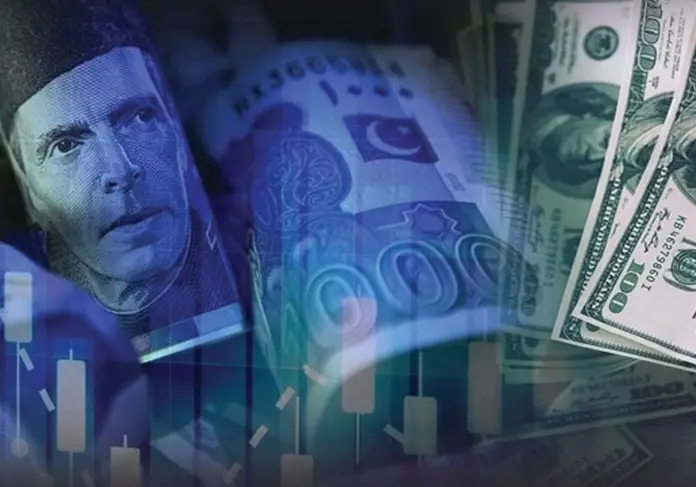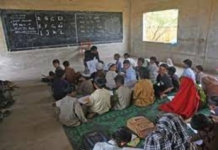Between 1950 and 1980, there was fixed exchange rate in Pakistan between the US dollar ($) and Pakistani rupee (Rs). The parity in 1950 was Rs3.3 to one US dollar that remained constant till 1971 and after the fall of Dhaka was devalued to Rs8.9 to one dollar. In 1981, when the fixed exchange rates were replaced by free or floating exchange rates to be determined by the market forces of supply and demand, the exchange rate was Rs9.9 to one US dollar. By 1991, the rupee had depreciated to Rs23.9 to one US dollar. In the next ten years rupee had further depreciated and in 2001 was Rs61.9 to one US dollar. In 2010, the rupee had further depreciated to Rs85.2 to one US dollar. After this there was a steady increase in depreciation of the rupee against the dollar. In 2020, the parity was Rs168.88 to one US dollar. In 2021 the exchange rate was on an average Rs179.2 to one US dollar and in July 2022, crossed Rs210 to one US dollar [source]. This huge slide of the Pakistani rupee against the US dollar is mainly contributed to the huge foreign trade and balance of payments deficit of Pakistan.
The factors that contribute to this sliding of rupee against the dollar are GDP Growth Rates; balance of payments and foreign trade deficit; inflation in the country; interest rates of the Central Bank (SBP); speculative demand of foreign currency (US dollar) against the local currency (Rs).
- GDP growth Rate: In 1951, Pakistan’s GDP growth rate was –1.8%, in 1971 it was 2.32% that rose to 6.80 in 1972. In 1981, Pakistan’s GDP growth rate was 7.56% and rose to 8.71 in 1984. In 1991, Pakistan’s GDP growth rate was 7.57% and in 2001 declined to 3.11%. Pakistan’s GDP growth rate was 1.61% and in 2020 it was minus (-) 1.33%. In 2021, Pakistan’s GDP growth rate was 6.0% and it is forecasted to almost 4% in 2022. (Source: Federal Bureau of Statistics, Pakistan). When the GDP growth rate increases, the domestic currency (rupee) declines against the foreign currency (dollar), because higher incomes tend to buy more foreign goods and therefore resulting in more demand of the dollar in Pakistan. Although the present government has banned the imports of many of the luxury items to Pakistan, but this policy has not impacted significantly in reducing the trade deficit of the country. On the contrary, the trade deficit has increased in July 2022.
- Foreign trade and Balance of Payments deficit: In July 2021, Pakistan’s Current Account deficit was minus US $0.77 billion, in December 2021, BOP deficit rose to minus US $1.88 billion. In January 2022, Pakistan’s BOP deficit rose to minus US $2.53 billion [Source]. In July 2022, this deficit rose to minus US $15.19 billion. At the same time Pakistan’s trade deficit in July 2022 is a record minus US $43.33 billion, while total foreign exchange reserves of the country came down from US $27 billion in July 2021 to US $8.24 billion in July 2022, although the foreign remittances from July 2021 till May 2022 (11 months) were a record US $28.41 billion. When Balance of Payment deficit is minus US$ 15.19 billion and the total foreign exchange reserves of Pakistan were US $8.24 billion, then it is obvious that the overall demand for foreign currency in the country would increase and Pakistani rupee against the dollar would depreciate. Also, the foreign exchange reserves have fallen, even when remittances to Pakistan have increased substantially.
- Inflation: Inflation in Pakistan reached the highest in 14 years and was 21.32% in June 2022, the reasons were both import of foreign inflation into the country as well as increase in petrol, electricity and other input prices resulting in cost-push inflation. The net result of this high inflation is that investors should demand more US$ where inflationary rates are relatively lower than in Pakistan and therefore the domestic currency (rupee) depreciated against the US $ as demand of dollar increased and demand for rupee decreased in foreign exchange market.
- Interest Rates: In November 2021, Pakistan’s bank rate was 8.75 points. In December 2021, these interest rates were increased to 9.75 points. In April 2022, bank rate was increased by SBP to 12.25 points and in May 2022 to 13.75 points and in July 2022 the bank rate is 15.0 percentage points [source]. This drastic increase in bank rate and subsequently in intrabank rate has increased significantly the interest rates at which commercial banks would be lending to the public and investors, thus increasing cost of doing business in the country, therefore the impact of these increase in interest rates on rupee-dollar parity would be that rupee would depreciate against the US $ and against other significant foreign currencies.
- Speculative demand for US dollars in Pakistan: A large part (Almost 50%) of Pakistan’s economy is undocumented and usually constitutes that portion which are tax evaders, and is even based in corruption, smuggling, and speculators of different kinds. When due to FATF, it has become difficult to hide this ill-gotten wealth, and when there is no amnesty scheme to whiten black money in the country, the more viable option is to buy dollars from the open market, increasing demand of foreign currency and thus depreciating the local currency. Many commercial banks have made huge profits within this one year by buying the US dollar from interbank as well as from open market where US dollar was appreciating from Rs179.2 in 2021 to Rs210.7 by July 2022. No other business would give a more than Rs30 per dollar profit in these few months.
In conclusion, it should be noted that when even the GDP growth rate declined from 6.0% to less than 4.0%, the rupee kept on depreciating, because the demand for foreign goods, machines, raw materials and even energy and food products from abroad kept on rising; BOP deficit reached minus US$ 2.53 billion and trade deficit to minus US $43.33 billion; the bank rates by SBP increased to 15%, and inflation rate went to a record 21.32%. On top of it all, speculative demand for dollars due to lack of investment opportunities in the country has aggravated the situation for Pakistan’s economy even further. Government of Pakistan should bring in an economic policy that helps increase production of exportable as well as import substitutes in the country and at the same time direct speculative demand for foreign currency towards real investment opportunities, so that employment and income generation opportunities in Pakistan are enhanced, thus bringing down inflationary pressures and stabilizing Pakistan’s rupee against the dollar. Till such time the balance of payment deficit is not minimized, the downslide of rupee against the US dollar and other important currencies would continue.







